Ukraine receives main battle tanks, including Leopard 2 from Germany. Has the Chancellor given in to international pressure – or was his hesitation intentional?
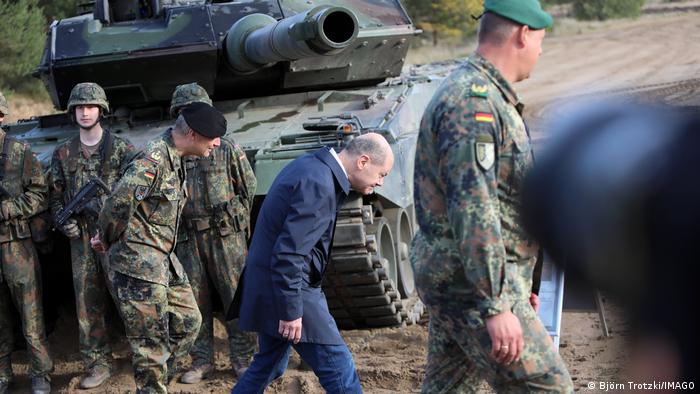
Chancellor Olaf Scholz ducked past a Leopard 2 A6 main battle tank last October
It was the SPD, the Chancellor's party, that rushed ahead even before the German government officially confirmed that Leopard 2 tanks would be shipped to Ukraine. Katja Mast, the parliamentary director of the SPD parliamentary group, spoke of a “huge diplomatic success” for Olaf Scholz. The Chancellor has managed to forge a broad international alliance, and that is extremely important in the current situation.
The USA actually didn't want to deliver main battle tanks, but now they are ready to do so. What counts is what comes out in the end, Mast said in response to the accusations that the chancellor had damaged Germany's reputation with his hesitant attitude and his days of hesitating on the tank issue. It was about the principle of avoiding going it alone and “not letting NATO become a war party,” says Mast. That has now happened and therefore the criticism of Scholz is “completely inappropriate”.
Telling the story again
The message of the SPD is: The chancellor has everything under control, because he knew what he did. He had a plan, absolutely wanted to get the Americans on board and didn't allow himself to be influenced by public criticism and discussions. He did everything right and wrote a success story.
Scholz is not someone “who follows the headlines and lets himself be fooled,” says Katja Mast. The decisive factor for him is his oath of office to “avoid damage to the German people”.
Two Leopard 2 battalions
Shortly before noon, the federal government then declared in writing. The government spokesman said that the chancellor had announced in the cabinet that Germany would continue to increase military support for Ukraine. The federal government has decided to provide the Ukrainian armed forces with Leopard 2 main battle tanks.
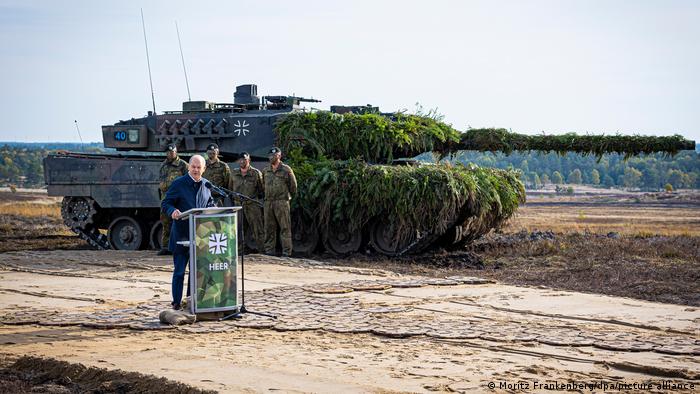
Olaf Scholz In October 2022 during a military exercise with the Leopard 2 main battle tank
We're talking about two tank battalions. In the Bundeswehr, a Leopard 2 battalion consists of 44 tanks. Two battalions would therefore be 88 tanks. In a first step, a company with 14 tanks from Bundeswehr stocks is to be handed over. Other European partners would also make Leopard 2 available. The training of the Ukrainian crews is to begin quickly in Germany. In addition to training, logistics, ammunition and system maintenance are also planned.
31 Abrams tanks from the USA
Of course, the German government spokesman wrote nothing about the US tank plans. However, as the US government has now announced, the USA is making 31 M1 Abrams tanks available. However, the Washington Post says it could be months, if not years, before they see action in the war.

Complicated device: The US Abrams main battle tank, here during an exercise in Latvia
According to the newspaper, it is unlikely that the vehicles will arrive in Ukraine in the spring, when the Russian offensive or a counter-offensive by Ukraine to recapture Russian-held areas is expected. The USA had always emphasized that it did not consider an Abrams deployment to be sensible for practical reasons. US Secretary of Defense Lloyd Austin has repeatedly stated that they do not want to supply Ukraine with any military material that they “cannot repair, cannot maintain and cannot afford in the long term”.
Scholz is concerned with the principle
However, Olaf Scholz was not impressed by the fact that the Abrams is said to be a very complicated device. Expensive to procure, demanding in terms of training and, with eleven liters of aviation fuel per mile, very fuel-hungry. Irrespective of the sense or nonsense of an Abrams delivery, it was all about the political signal.
“So far, the depletion of the material used by the Ukrainian army has been offset by the supply of material of Soviet origin, which European countries and NATO members still had because of their history,” explains Eric-André Martin of the Institut français des relations Internationales (IFRI). in Paris to DW. “As a result, from the outside, especially from Russia, it was invisible where these tanks came from.”
Escalation towards Russia
Unlike the old Soviet tanks, it is clear where the Leopard 2 tanks came from. Especially since they are produced in Germany and the federal government has to agree if third countries want to pass the tank on. The question is to what extent the Russians see this as a new level of escalation in this war and how they will react to it, said Eric-André Martin. “The Russians could be of the opinion that Germany is always in the know and is always involved in every delivery.”
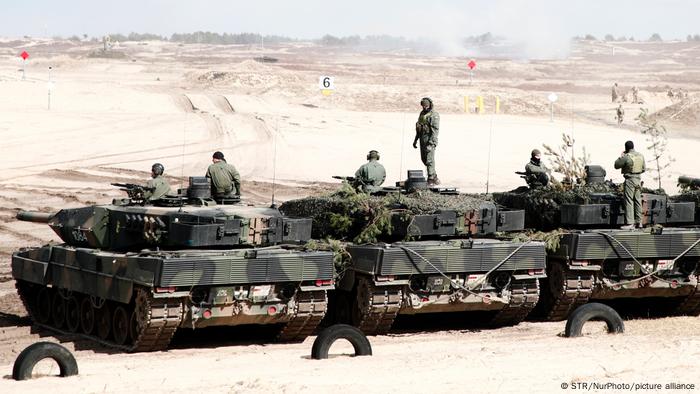
Poland announced a few days ago that it intends to hand over Leopard 2 tanks to Ukraine
As if in confirmation, the Russian Ambassador to Germany Sergey Nechayev reacted sharply. He wrote via Telegram that the delivery of Leopard 2 would “take the conflict to a new level of confrontation”. The West finds itself in a logic of “permanent escalation”. And Nechayev also wrote: Germany does not live up to its historical responsibility for the Nazi crimes. “With the permission of the German government, tanks with German crosses are once again being sent to the 'Eastern Front'.”
Germany does not want to take the risk alone
From the Russian embassy in Berlin it is only a few steps to the Reichstag building. There, Chancellor Scholz declared himself in the Bundestag at noon and answered questions from the MPs. It is right and important that “very effective weapon systems” are only made available in close cooperation with international partners. According to Scholz, it is important to prevent the risks for one's own country from “growing in the wrong direction”.
Scholz: “Trust the federal government!”
Was that what Scholz made clear to US President Joe Biden in a phone call on January 17? The subsequent press release by the German government spokesman was unusually brief. The Chancellor exchanged views with the President of the United States of America on the situation in Ukraine. “The focus was on the issue of supporting Ukraine in its fight against Russian aggression. Both agreed that this support must be effective, sustained and closely coordinated.”
“Working forward bit by bit”
The Americans' press release was also brief, but only mentioned that Biden and Scholz had discussed their “steadfast” and “continued support for Ukraine”. Not a word about close voting. What was said in the call is not public. However, the reaction of the Americans suggests that Scholz and Biden were still far apart in terms of content on January 17.
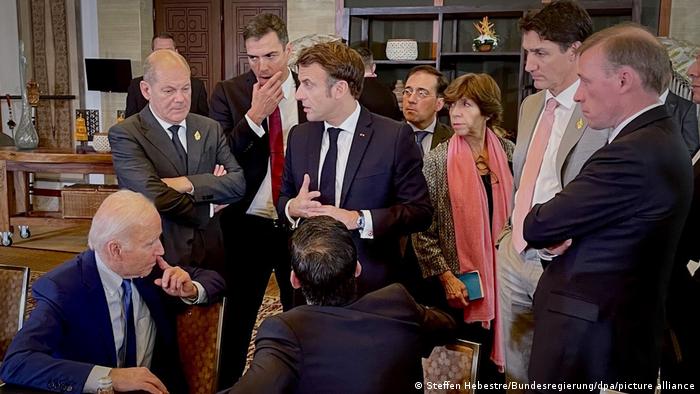
Only moving forward together: US President Joe Biden, Chancellor Olaf Scholz, Pedro Sánchez, Prime Minister of Spain, Emmanuel Macron, President of France, Rishi Sunak, Prime Minister of Great Britain, and Justin Trudeau, Prime Minister of Canada, in November 2022 in Indonesia at the G20 Summit
It was “right and done with full intention” that we “worked our way forward bit by bit” and “didn't let it drift,” Scholz explained in the Bundestag. He also presents his hesitation in retrospect as his party does. “All the hasty judgments evaporate in hot air. Germany is neither slowing down nor is it isolated,” writes SPD parliamentary group leader Rolf Mützenich in a letter to the Social Democratic members of the Bundestag.
Hesitantly, also with a view to the SPD
But how could Scholz be sure that his plan would work? A question that can hardly be answered in hindsight. Basically, it is something like a character trait of Olaf Scholz that he sticks to a path once he has taken it. But there is another reason why he doesn't want to expose himself single-handedly in providing military support to Ukraine: his party and his voters.
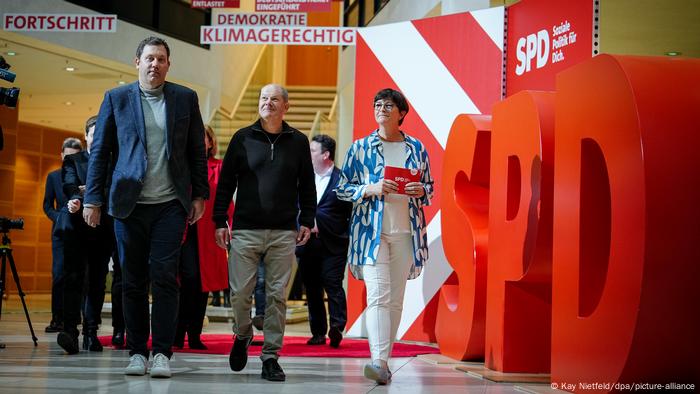
Decisions only in close consultation: Chancellor Olaf Scholz (middle) with the SPD chairmen Lars Klingbeil and Saskia Esken
The supporters of the SPD are wondering whether Germany should deliver even more weapons to the Ukraine than before , split. Within the party itself there is a strong left wing with many advocates of an anti-militarist and pro-peace policy line. Good relations with Russia were a matter of course for them until the attack on Ukraine and a peace order in Europe without Russia was unimaginable.
Don't risk factional fighting in the SPD
Olaf Scholz belongs to the right wing of the party on. Right in the sense of non-ideological and pragmatic. As chancellor, he has the respect of his party, but under no circumstances can he push through a policy that goes against the grain of the SPD. That would revive the old factional struggles in the SPD, over which many party leaders have fallen. This is one of the reasons why the chancellor is taking things slowly and prefers to risk being perceived as hesitant, even internationally.